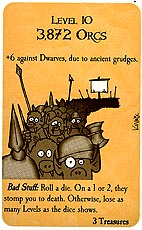I've started D&D with 3rd edition, which introduced encounter building based on challenge rating, party size, PC levels, and so on, and you got XP for defeating them in battle (which everyone read as "killing"). So when I occasionally saw monster stats for Basic or AD&D that said orcs have "No. appearing 30-300", or 2-16 hill giants as random encounters, that seemed just nonsensical and something that surely everyone always ignored.
But when you bring reaction rolls (about 50-50 chance that there will be a fight), morale checks (don't have to kill all to win the fight), and XP for treasure (don't have to fight at all to get your reward) into the picture, things of course really change quite a lot. Now that I am gearing up for another B/X campaign, intending to use the rules in the ways they were designed for, I want to dive into this topic again and see if I can work out how these things are supposed to actually work.
This post is kind of my explanation of how I currently understand it myself, which just might be useful or interesting to some as it is, but I'm really looking forward to hear any corrections, additions, or suggestions to make this whole aspect of the game work better.
The assumption here is that different areas have different difficulty levels. While it's generally assumed that each dungeon level corresponds to each floor of the dungeon, to make it clearly visible for players that they move into a more dangerous area, that doesn't have to be the case. You can have a more dangerous dungeon where the first floor is "dungeon level 3", the second floor "dungeon level 4", and so on. Or you can have a ruined castle where the whole lower keep is "dungeon level 1", the upper keep "dungeon level 2", and the basements beneath the upper keep "dungeon level 3". Having every dungeon laid out like a parking garage with the same critters on the top level would get pretty boring. (Which I suspect is where the concept of megadungeons comes from. Don't start a new dungeon, just keep going deeper forever.)Originally Posted by Basic Rules, p. B30: "Monsters"
I think it's also important to note, because that part often seems to be glossed over, that there are really four different numbers for different situations.
- Dungeon Wandering (i.e. 2-8 orc warriors)
- Dungeon Lair (i.e. 10-60 orc adults plus 10-60 children)
- Wilderness Wandering (i.e. 10-60 orc warriors)
- Wilderness Lair (i.e. 50-300 orcadults, plus 50-300 children)
600 orcs is not what you get in a random encounter between two rooms in a dungeon. 600 orcs is a village.
Here I am a bit uncertain what the original intention might have been. It seems like parties traveling in the wilderness might randomly come across lairs. But there appears to be no mention anywhere on when to make a wilderness encounter Wandering Monsters or a Lair. Entirely possible that it's left completely up to the GM to roll a wandering group or a lair, but I'm still curious for what the assumed practice would have been.Originally Posted by Expert Rules, p.X54: "Designing a Wilderness"
Originally Posted by Basic Rules, p. B30: "Monsters"
While it doesn't actually say so, I think it seems really sensible to say that if the dungeon includes a goblin lair somewhere, then all wandering goblins are part of that lair but currently on patrol, exploring, or hunting. Creatures of types that have no lairs in the dungeon would simply be exploring or hunting temporarily in the dungeon.Originally Posted by Basic Rules, p. B53: "Wanderig Monsters"
I areas close to the lair, the corresponding creatures should be more likely to encounter as Wandering Monsters than they are in other parts of the dungeon.
What are your thoughts on Wilderness Lairs, though? Should they be something that can be randomly encountered while traveling through the wilderness? Given that there's a 3% chance that randomly encountered creatures are friendly to the PCs (or much higher if the leader has good Charisma), I could see a wandering patrol or hunting band invite the party to come to their village to rest or resupply. And then being able to have a ready made wilderness lair that you can pull out of your sleeve would be really handy.
Or you defeat a group of hostile wanderers, or spot them while remaining undetected, and then follow them back to their lair. I think those could make for really awesome spontaneous adventures.
View Single Post
-
2021-03-09, 09:28 AM (ISO 8601)Titan in the Playground


- Join Date
- Apr 2009
- Location
- Germany
 Numbers encountered, Wandering Monsters, and Lairs
We are not standing on the shoulders of giants, but on very tall tower of other dwarves.
Numbers encountered, Wandering Monsters, and Lairs
We are not standing on the shoulders of giants, but on very tall tower of other dwarves.
Spriggan's Den Heroic Fantasy Roleplaying



 Reply With Quote
Reply With Quote